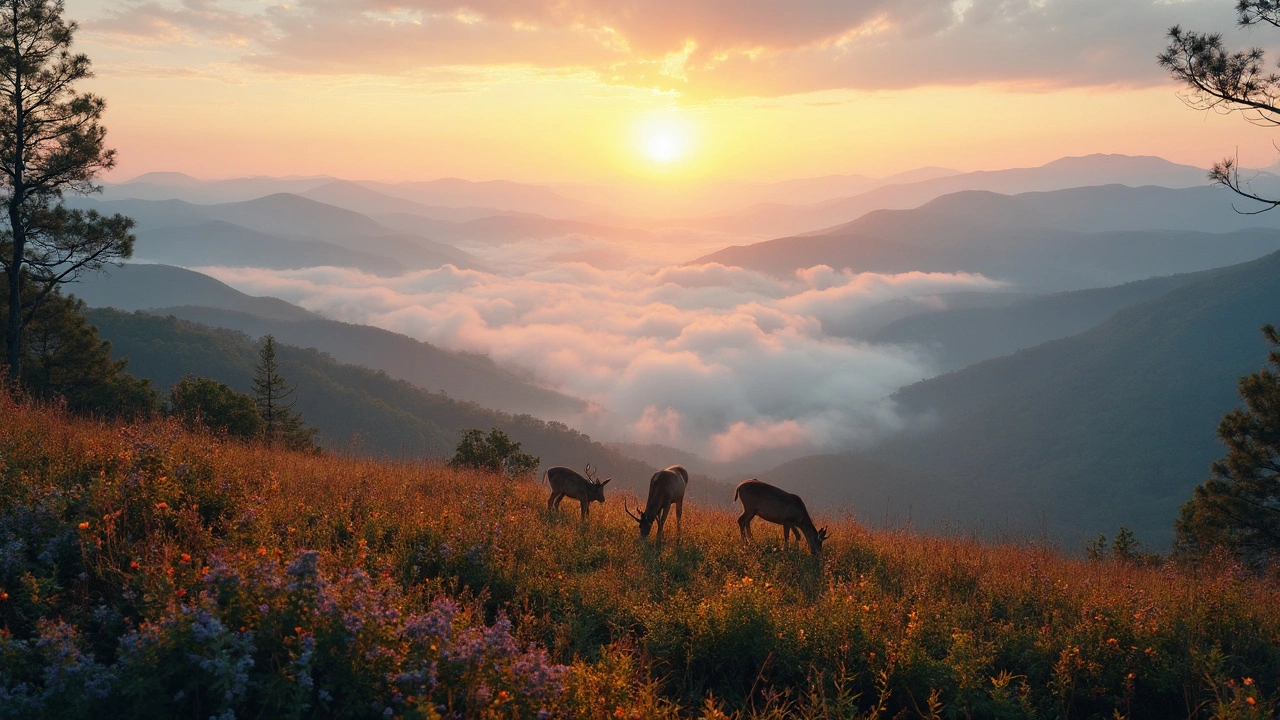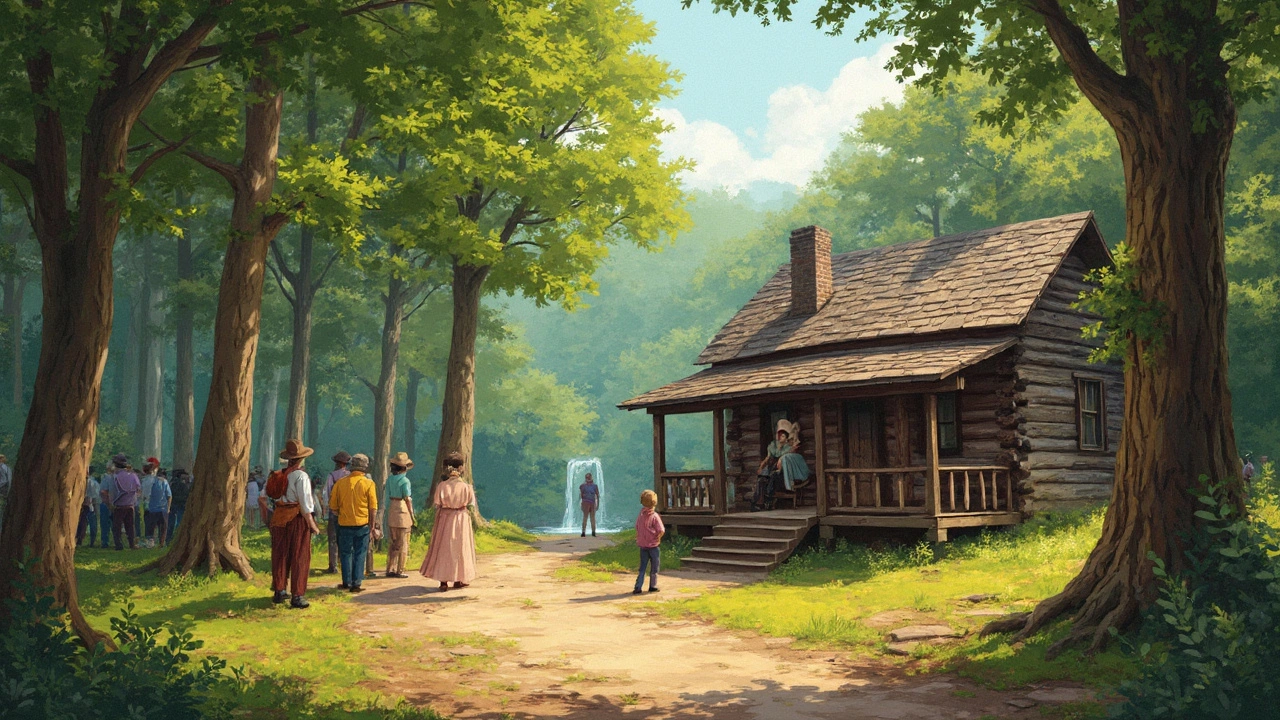Why Smoky Mountain National Park Tops the List

Ever wondered why Smoky Mountain National Park has such a fan following? It seems like everyone and their uncle has it on their bucket list. So, let's unravel the mystery. This place isn't just about trees and trails; it's a sprawling expanse of thrilling landscapes, teeming with wildlife and quirky stories from the past.
This park covers over half a million acres across North Carolina and Tennessee, offering some of the most unforgettable vistas. Imagine mist-shrouded mountains at sunrise; they're like nature’s own magic show. And it's not just about the views. With more than 1,500 types of flowering plants, you're literally stepping into a living, breathing botanical gallery.
But wait, there's more! The park hosts a slew of outdoor activities—from novice-friendly hikes to challenging backcountry treks. You can even pretend you're Indiana Jones exploring hidden spots, like the mystical Alum Cave Trail or the ancient Cherokee sites sprinkled throughout. It's an adventure playground for all ages.
- Stunning Landscapes and Views
- Rich Biodiversity
- Hiking and Outdoor Activities
- Cultural and Historical Significance
- Travel Tips and Best Times to Visit
Stunning Landscapes and Views
If you're chasing jaw-dropping sceneries, Smoky Mountain National Park is a no-brainer. This park features a diverse range of landscapes that can make even a seasoned traveler do a double-take. Whether you're hanging out at one of the many peaks or wandering through lush valleys, the views here don't disappoint.
Famous Peaks and Overlooks
Clingmans Dome is the highest point in the park and a must-see for any visitor. At 6,643 feet, it offers panoramic views that extend over 100 miles on a clear day. Tip: Get there early to catch the sunrise and you might just be treated to the sight of the clouds rolling over the landscape—it's how the park got its mesmerizing name.
Then there's the Cades Cove, a broad valley famous for its stunning 360-degree views. It's one of the most popular spots due to its accessibility and beauty. Plus, the drive through the cove is littered with chances to glimpse wildlife like deer and, if you’re lucky, black bears!
Captivating Waterfalls
Who can resist the allure of cascading waterfalls? The park has more than a few. Laurel Falls and Abrams Falls trail are crowd favorites. They're not just pretty—they’re accessible, making for great family outings. Remember to pack some snacks and water before heading out.
Diverse Ecosystems
The park isn’t just a visual treat. Its landscape fosters a wide range of habitats. You can't talk about the park without mentioning its impressive biodiversity. Whether you're exploring its bountiful florals or peering into its diverse fauna, each visit feels like a new experience. It's the kind of place where even seasoned experts find something surprising.
| Location | Elevation (Feet) | Travel Time (Hours) |
|---|---|---|
| Clingmans Dome | 6,643 | Up to 2 depending on traffic |
| Cades Cove | 1,800 | 1 for the loop |
Each season brings its own palette, whether it's the vibrant blooms of spring, the lush green of summer, the fiery reds and oranges of fall, or the serene whites of winter. The views change, but they’re always breathtaking.
So, if you've got your camera ready and a thirst for adventure, the Smoky Mountain landscapes are calling. You might find yourself coming back every chance you get!
Rich Biodiversity
If you're a nature lover, the Smoky Mountain National Park is like hitting the jackpot with biodiversity. This place is a real-life jungle book, teeming with diverse plant and animal life. We're talking over 19,000 documented species and counting, thanks to ongoing research and exploration!
One of the park's biggest claims to fame is its remarkable plant life. More than 100 species of native trees can be found here, more than in any other North American national park. In the spring, wildflowers transform the park into a spectacular riot of colors. Biological diversity stretches beyond botany, though—critters of all kinds call this park home too.
Wildlife that Wins Hearts
You can't talk about the park without mentioning its most iconic residents, the black bears. They're practically celebrities around here. With around 1,500 black bears in the park, you're in for a treat if you spot one (from a safe distance, of course). But the park isn’t just about the bears.
Birdwatcher? You'll be in heaven. There are over 200 species of birds flitting about. You might catch sight of the stunning peregrine falcon or hear the sweet melody of the wood thrush. The park’s streams are teeming with life too, including the elusive brook trout.
Status: Biodiversity Hotspot
Fun fact—did you know that the Smokies are part of the International Biosphere Reserve? This status highlights the global importance of its natural resources and ecosystems. Scientists around the world are fascinated by the park’s ability to host such a sweep of life.
| Species Type | Numbers |
|---|---|
| Plant Species | More than 1,800 |
| Animal Species | Over 19,000 (including not yet discovered ones) |
| Bird Species | Over 200 |
| Black Bears | Approx. 1,500 |
With numbers like these, it's no wonder Smoky Mountain is a beloved sanctuary for life of all kinds. If biodiversity is your thing, this park is a must-see. It’s a living laboratory, and who knows? You might just discover something new on your hike!

Hiking and Outdoor Activities
The Smoky Mountain National Park is a go-to spot for outdoor lovers. With over 800 miles of trails, it caters to everyone—from the casual stroller to the hardcore hiker. Fancy a short, easy hike? Check out the Laurel Falls Trail. It's just 2.6 miles round trip and gives you a peek at one of the park's most popular waterfalls without breaking a sweat.
For the Thrill Seekers
If you're up for a bigger challenge, the Alum Cave Trail is your jam. It's a 5-mile trek to the top of Mount LeConte, where you'll be rewarded with jaw-dropping views. The ascent is steep, but hey, that makes the victory even sweeter!
Nature on Two Wheels
Not just about hiking, this park also throws in some cool biking options. Cades Cove Loop Road is perfect for cyclists. Every Wednesday, it's car-free until 10 AM. So, you can pedal away without worrying about traffic.
Fishing and Wildlife Watching
For those who prefer a rod over a rucksack, there's a fishing paradise waiting for you. With around 2,900 miles of streams, you can fish for trout all year long. And if you're more into just chilling out and watching wildlife, Cades Cove is the spot to be. You're pretty much guaranteed to spot white-tailed deer, black bears, wild turkeys, and more.
Don't Forget the Camping
Want to make it an overnight journey? The park offers frontcountry and backcountry camping. Just remember to pack up everything you bring in. It's a popular spot, so make sure you reserve your spot well in advance, especially during peak season from late spring to early fall.
Finally, here's a quick tip: Spring and fall offer the most comfortable weather and stunning scenery changes. But don't let a little cold scare you away in winter, as the snow-covered peaks are breathtaking. Whatever the season, this national park delivers an experience like no other.
Cultural and Historical Significance
Diving into the past of the Smoky Mountain National Park is like flipping through the pages of a storybook. This place is steeped in history and culture, each corner echoing tales from yesteryears. You can almost feel the whispers of the original Cherokee inhabitants who called these mountains their home long before any frontier settlers arrived.
Cherokee Legacy
The Cherokee Nation, arguably the most famous of the Native American tribes in this region, left behind a legacy intertwined with the Smoky Mountain landscape. They referred to these mountains as "Shaconage," which translates to the land of blue smoke. Their connection with this land is still palpable today with numerous efforts to preserve their culture and contributions.
Several trails and areas have Cherokee names, and you can visit sites like the Oconaluftee Indian Village to experience a taste of their history and daily life. This living museum offers a peek into traditional Cherokee crafts, dances, and community life.
Early Settlers and Appalachian Heritage
Fast forward to the 1800s and you'll find tales of pioneers who braved harsh conditions to settle in these areas, farm the land, and carve out livelihoods. These early settlers left behind the Appalachian heritage that still thrives today. You can explore reconstructed homesteads at Cades Cove—a picturesque valley that showcases life as it was back then with its log cabins, barns, and churches.
The Appalachian culture resonates through music and stories passed down generations. If you time your visit right, you might stumble upon a local bluegrass festival, where fiddles and banjos bring the pioneer spirit alive.
Preservation Efforts
The park was officially established in 1934, but the journey to protect these lands began much before. The impact of logging industries in the early 20th century posed severe threats, but thanks to conservation efforts, the park is now a protected sanctuary. Today, the small towns bordering the park maintain its delicate balance between nature and history.
To truly appreciate its cultural and historical significance, spare some time to visit the Mountain Farm Museum and Mingus Mill—two spots that highlight the park's rich past and ongoing efforts to preserve it.

Travel Tips and Best Times to Visit
Planning a trip to the Smoky Mountain National Park can feel daunting, but with the right info, you'll be ready to hit the trails. First off, let's talk timing. The park is open year-round, but certain seasons offer something special.
Best Times to Visit
If you're aiming for vibrant fall foliage, late September to early November is golden. Autumn turns the park into a kaleidoscope of colors, drawing big crowds, so plan accordingly. For wildflower fanatics, spring, especially April and May, is when the blooms are at their peak.
Summer is ideal for those wanting to camp or hike, but it's also the busiest period. Winter offers a quieter experience; it's great for solitude seekers willing to brave the cold.
According to the National Park Service, "The Smokies are known for panoramic views and seasonal diversity, rewarding visitors with new experiences with each return visit."
Travel Tips
- Accommodation: Book your stays well in advance, especially if you're visiting during peak seasons.
- Weather Prep: The park's weather is notoriously unpredictable, so pack layers. A sunny morning can quickly turn into an afternoon storm.
- Early Bird Advantage: Arriving early to popular spots can help avoid crowds.
- Trail Info: Grab a map. GPS and cell service might let you down in the backwoods.
- Leave No Trace: Respect nature. Carry out what you carry in.
Accessibility
The park offers various accessibility options for travelers with mobility issues. Key lookout points, like Clingmans Dome, have paved paths for wheelchair access, so everyone can soak up those views.
| Season | Activities |
|---|---|
| Spring | Wildflower viewing, hiking |
| Summer | Camping, hiking |
| Autumn | Leaf peeping, photography |
| Winter | Winter solitude, cross-country skiing |
Remember, no trip to the Smoky Mountain is complete without a bit of planning, so keep these tips handy. Now, go make some memories!